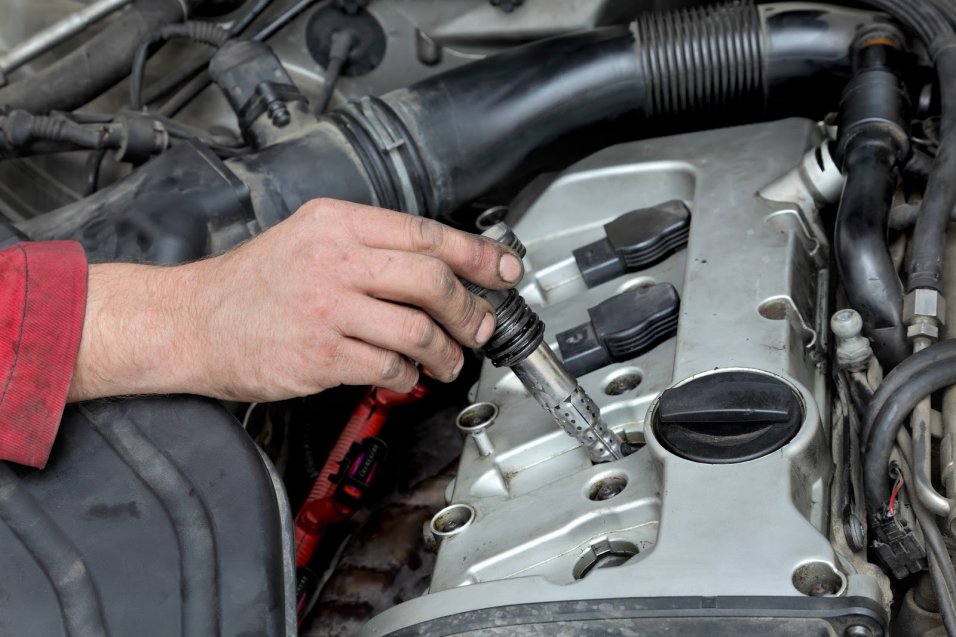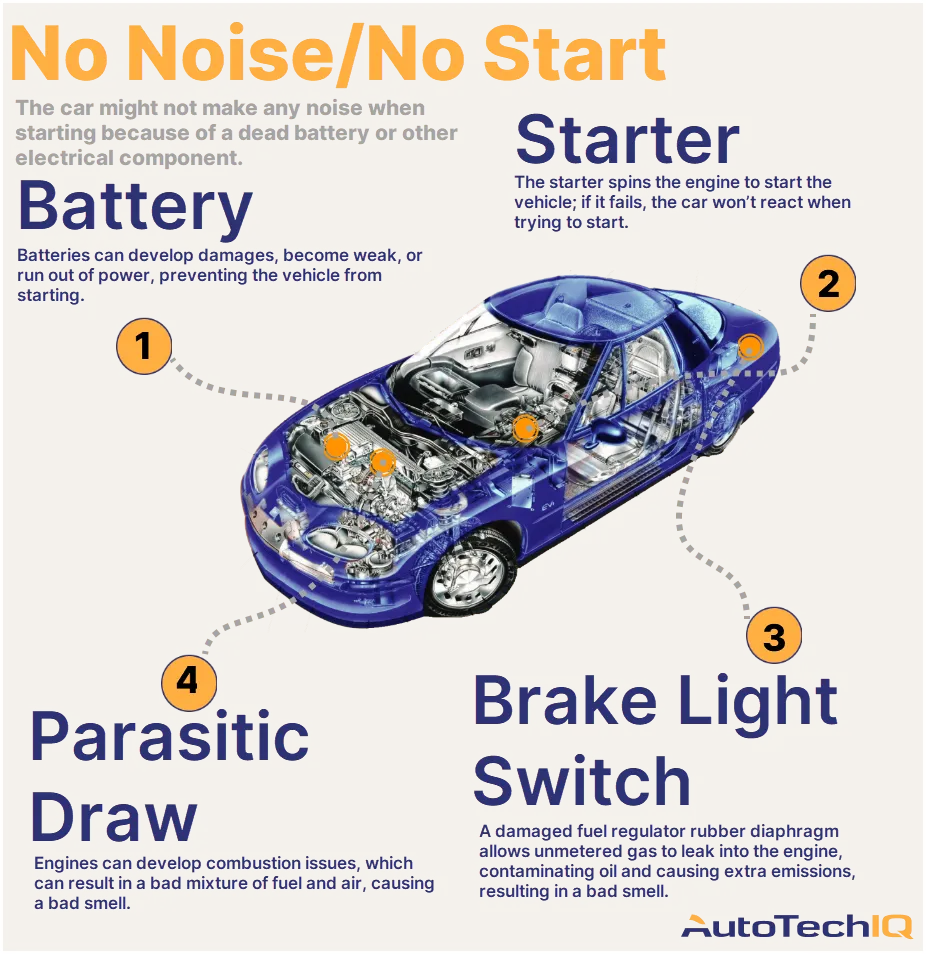As an Amazon Associate, I earn from qualifying purchases at no extra cost to you.
Can Spark Plugs Cause Car Not To Start: Troubleshooting Guide
Yes, spark plugs can cause your car not to start by failing to ignite the fuel-air mixture. Spark plugs are essential for combustion in the engine.
When the spark plugs are worn out or not functioning correctly, the engine may not start as needed. Several factors, including a dirty or damaged plug, can lead to ignition failure, resulting in the car not starting. It’s crucial to regularly inspect and replace spark plugs to ensure the proper functioning of your vehicle.
Ignoring spark plug issues can lead to more severe problems down the road, affecting your car’s overall performance and reliability. In this guide, we will explore the impact of spark plugs on your car’s starting process and provide solutions to address potential issues effectively.
Common Causes Of A Car Not Starting
Several factors can lead to a vehicle not starting, causing frustration and inconvenience to the driver. Understanding these issues can help in diagnosing and resolving the problem quickly.
Defective Spark Plugs
Worn-out or damaged spark plugs can prevent the engine from starting smoothly as they are responsible for igniting the fuel mixture. If spark plugs are in poor condition, the car may fail to start at all.
Faulty Ignition System
The ignition system, including components like the ignition coil and distributor, plays a crucial role in starting the engine. Any malfunction in these parts can result in the car not starting correctly.
Low Fuel Level
A simple yet common issue that can prevent a vehicle from starting is having too little fuel in the tank. Running on low fuel can lead to the engine not receiving adequate fuel supply to start.
Signs Of Faulty Spark Plugs
Spark plugs are a vital component of your car’s engine that produce the necessary ignition for the combustion process, but when they start to fail, it can cause serious issues, even preventing your car from starting altogether. Recognizing the signs of faulty spark plugs is crucial to preventing potential breakdowns and expensive repairs.
Rough Engine Idling
A rough engine idling is a common indicator of faulty spark plugs. When the spark plugs are worn or dirty, they fail to ignite the fuel properly, causing the engine to run unevenly. If you notice your car vibrating or shaking while idling, it could be a sign that the spark plugs need attention.
Difficulty Starting The Engine
Difficulty starting the engine is often associated with faulty spark plugs. If you find that your car takes several attempts to start, or there’s a prolonged cranking before the engine fires up, it might be due to worn-out or fouled spark plugs.
Decrease In Fuel Efficiency
A decrease in fuel efficiency can also signal a problem with the spark plugs. When spark plugs aren’t performing optimally, the engine can’t burn the fuel efficiently, leading to increased fuel consumption. If you find yourself making more frequent stops at the gas station without any other explanation, it could be time to check your spark plugs.
How To Check Spark Plugs
When dealing with a car that won’t start, it’s crucial to check the spark plugs. If they are worn out or malfunctioning, it can lead to ignition issues, causing the car not to start. Checking and possibly replacing the spark plugs can resolve this problem, ensuring smooth starting of the vehicle.
When your car refuses to start, it can be quite frustrating and oftentimes, the culprit can be faulty spark plugs. Spark plugs play a crucial role in the ignition system of your vehicle, delivering the spark that ignites the fuel-air mixture in the combustion chamber. If your spark plugs are worn out or damaged, they can cause a weak or nonexistent spark, resulting in difficulty starting the car. In this section, we will guide you on how to check spark plugs to ensure they are in good condition and functioning properly.Inspecting Spark Plug Condition
To begin checking your spark plugs, you’ll need to inspect their overall condition. Follow these steps:- Open the hood and locate the spark plugs. They are usually housed in the cylinder head and can be identified by their rubber, silicone, or ceramic insulators.
- Inspect the spark plugs for signs of wear, such as cracks, damage, or excessive carbon buildup.
- Check the plug’s electrode for any signs of erosion or corrosion, as this can affect their performance.
- If any of the spark plugs are damaged or worn out, it is recommended to replace them with new ones.
Measuring Spark Plug Gap
The spark plug gap refers to the distance between the center and ground electrode. It plays a crucial role in ensuring the proper firing of the spark plug. Follow these steps to measure the spark plug gap:- Use a spark plug gap tool, which is a small, flat tool with varying thicknesses.
- Select the appropriate thickness for your spark plug gap and insert it between the electrodes.
- Gently twist the tool to increase or decrease the gap until it matches the manufacturer’s specifications.
- Ensure the gap is uniform across all spark plugs. If not, adjust accordingly.
Testing Spark Plug Wires
In addition to the spark plugs themselves, the spark plug wires also play a vital role in the ignition system. Faulty spark plug wires can prevent the spark from reaching the plugs, causing starting issues. Here’s how you can test them:- Start by visually inspecting the spark plug wires for any visible damage, such as cracks, worn-out insulation, or loose connections.
- If the wires appear damaged, it is recommended to replace them with new ones.
- For further testing, you can use a digital multimeter to check the resistance of each spark plug wire.
- Refer to your vehicle’s manual or a reliable online source to determine the acceptable range of resistance for your specific wires.
- If any spark plug wire falls outside the acceptable range, it should be replaced.

Credit: www.ymfcarparts.co.uk
Steps To Troubleshoot Spark Plug Issues
If your car refuses to start, faulty spark plugs could be to blame. Troubleshoot spark plug issues by checking for worn out or dirty plugs, proper gap spacing, and good ignition system connection. Follow these steps to get your car running smoothly again.
Replacing Spark Plugs
One of the common culprits when your car refuses to start is a faulty spark plug. Spark plugs play a crucial role in igniting the fuel-air mixture within the engine cylinders, so if they are worn out or damaged, it can lead to starting issues. To troubleshoot spark plug issues, the first step is to inspect and replace any faulty spark plugs. Here’s a step-by-step guide to help you through the process:
- Start by opening the hood of your vehicle and locating the spark plugs. Refer to your car’s manual to determine their exact location.
- Once you have found the spark plugs, disconnect the spark plug wires from each plug. Be careful not to pull on the wires themselves, as they can be fragile.
- Using a spark plug socket and a ratchet, carefully remove the old spark plugs from the cylinder head. Pay attention to the gap on the old plugs and ensure that the new ones have the same gap measurement.
- Before installing the new spark plugs, apply a small amount of anti-seize lubricant to the threads. This will prevent the plugs from seizing in the cylinder head and allow for easier removal in the future.
- Gently thread the new spark plugs into the cylinder head by hand, being careful not to cross-thread them. Once the plugs are finger-tight, use the spark plug socket and ratchet to snug them up. Avoid overtightening, as this can damage the threads or the plugs themselves.
- Finally, reattach the spark plug wires to their respective plugs, ensuring a snug fit. Double-check that all connections are secure and start your car to see if the new spark plugs have resolved the starting issue.
Testing Ignition Coils
If replacing the spark plugs did not solve the starting problem, the next step is to test the ignition coils. Ignition coils are responsible for converting the battery’s low voltage into a high voltage that sparks the spark plugs. A faulty ignition coil can result in a weak or no spark, making it difficult for your car to start. Follow these steps to test the ignition coils:
- Start by disconnecting the negative terminal of the car battery to prevent any accidental electrical shocks.
- Locate the ignition coil(s) in your vehicle. Depending on the make and model, you may have a separate coil for each spark plug or a single coil that fires multiple plugs.
- Using a multimeter set to the resistance or ohms function, check the resistance of each ignition coil. Refer to your car’s manual for the specific resistance range, as it can vary.
- If any of the ignition coils have a resistance reading outside the recommended range, they are likely faulty and need to be replaced.
- Before installing the new ignition coil(s), make sure to clean the areas where they will be installed to ensure proper contact and connection.
- Once the new ignition coil(s) are in place, reconnect the negative terminal of the car battery and start your vehicle to see if the starting issue has been resolved.
Cleaning Or Replacing Spark Plug Wires
If neither replacing the spark plugs nor testing the ignition coils solved the starting problem, it’s time to inspect the spark plug wires. Damaged or worn-out spark plug wires can cause a weak or inconsistent spark, resulting in starting difficulties. Here are the steps to clean or replace them:
- Again, start by disconnecting the negative terminal of the car battery for safety.
- Locate the spark plug wires, which are usually connected to the ignition coils and spark plugs.
- Inspect the wires for any visible damage, such as cracks, worn-out insulation, or loose connections.
- If the wires appear damaged, it is recommended to replace them with new ones. If there are no visible signs of damage, a simple cleaning can help optimize their performance.
- To clean the spark plug wires, gently wipe them down with a clean cloth dampened with electrical contact cleaner.
- After cleaning or replacing the spark plug wires, reconnect the negative terminal of the car battery.
- Start your vehicle to see if the cleaning or replacement of the spark plug wires has resolved the starting issue.
Other Possible Culprits For No-start Issues
When your car fails to start, a faulty spark plug is often to blame. However, there are other potential culprits that can result in a no-start issue. In this section, we’ll explore other possible causes for a car not starting, including a defective battery, an empty gas tank, and a faulty starter motor.
Defective Battery
If your car’s battery is defective, it may not have enough power to start the engine. This can happen due to corrosion on the battery terminals, a weak charge, or simply reaching the end of its lifespan. To troubleshoot this issue, you can use a multimeter to check the voltage of the battery or have a professional test it.
Empty Gas Tank
Another common reason for a car not starting is an empty gas tank. While it may seem obvious, sometimes we overlook the simplest solutions. Always ensure your gas tank has an adequate amount of fuel before assuming there is a more complex issue at play.
Faulty Starter Motor
If the starter motor is faulty, it can prevent the engine from turning over, resulting in a no-start condition. This can be due to worn-out brushes, a damaged armature, or electrical issues. If you hear a clicking noise when you turn the key but the engine does not start, the starter motor may be the culprit. In this case, it’s best to seek professional assistance to diagnose and address the problem.

Credit: www.ifitjams.com
Professional Assistance And Diy Options
A malfunctioning spark plug can lead to a car not starting. Seeking professional help or opting for a DIY approach can resolve this issue. Knowing when to seek mechanic help and having the necessary tools for a DIY spark plug replacement is crucial.
When To Seek Mechanic Help
Consult a mechanic if you lack experience with automotive repairs or if the issue persists after replacing spark plugs. Complex engine problems require professional expertise.
Tools Needed For Diy Spark Plug Replacement
The basic tools required for DIY spark plug replacement include a spark plug socket, ratchet, extension bar, and a gap gauge. Refer to the vehicle manual for specifications.
Consider using dielectric grease, anti-seize compound, and a torque wrench to ensure proper installation. Refer to online tutorials for step-by-step guidance.
Preventive Maintenance Tips For Spark Plugs
Regularly Inspecting Spark Plugs
Inspect spark plugs periodically to ensure they are in good condition.
Using High-quality Fuel
Opt for high-quality fuel to maintain spark plug efficiency.
Avoiding Over-tightening Spark Plugs
Avoid over-tightening as it may damage the spark plug threads.

Credit: www.autotechiq.com
Conclusion
Spark plugs can indeed be the culprit behind a car not starting. As essential components of the ignition system, faulty or worn-out spark plugs can result in weak or no spark, causing engine misfires. It is important to regularly check and replace spark plugs to ensure optimal engine performance and prevent starting issues.
If your car refuses to start, make sure to consider the condition of your spark plugs as a potential cause. Keep your engine in tune and get your spark plugs checked and replaced if necessary to prevent any inconvenience on the road.











